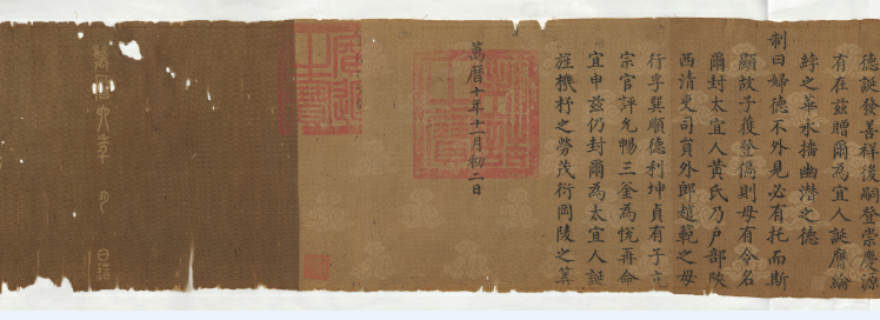An Edict Issued by the Wanli Emperor - Three Students Report on a Ming Dynasty Manuscript
In December 2020 the University Library acquired a Ming edict once in the collection of the Dutch sinologist Robert van Gulik. Three Chinese Studies students report on its restoration and academic relevance.
First Impressions
When the edict arrived, it was in a fragile condition. The edges were severely damaged, with a few tears on the top and bottom, and, from the top of the scroll, some fabric was missing. The nature of the damage indicates that the rolled-up scroll could have been pressed flat due to its rigid supporting core being lost, which would have caused these vertical cracks. Robert van Gulik’s youngest son, Thomas van Gulik, gave us some insight into his father’s collecting habits. Robert van Gulik’s desk was often littered with small curiosa. Not everything had to be expensive and Van Gulik bought items he came across spontaneously. He was above all interested in anything he found attractive. As far as scrolls are concerned, he would typically ask himself whether or not a potential new purchase would fit in his extensive collection. The scrolls were kept at home, in boxes in his study. Countless scrolls were also stored in the drawers of his desk. When friends came for a visit, a selection of the scrolls was rolled out and studied, criticized and commented upon. The format of the scrolls is a boon to the collector: they can be easily rolled up and stored away.
Dating the Edict
Two dates are visible on this sixteenth-century edict. The first date, woven in the fabric in seal script (篆書 zhuanshu) and followed by the character for “make/build/manufacture/fabricate” (造 zao), indicates when the scroll was manufactured. It refers to the sixth year of the Wanli reign (1572-1620), the month and the day are left blank. Converted to the western calendar, this year corresponds to 1578. The second date appears at the end of the main text: 萬曆十年十一月初二日. This converts to Friday, November 26, 1582.
An Analysis of the Material and the Text
The text of an edict is usually either written, stamped, or printed on the material. In this case, it has been written directly on the silk in standard script (楷書 kaishu). The text consists of thirty-one columns, with a maximum of thirteen characters per column. Two characters at the top right corner are missing (天 tian and 皇 huang). The reading direction is from right to left. Three seals are still visible: two imperial seals engraved in seal script (The Treasure Seal of the Imperial Decree ”制誥之寶”, and The Treasure Seal of Far-Reaching Influence “廣運之寶”), and van Gulik’s personal seal.
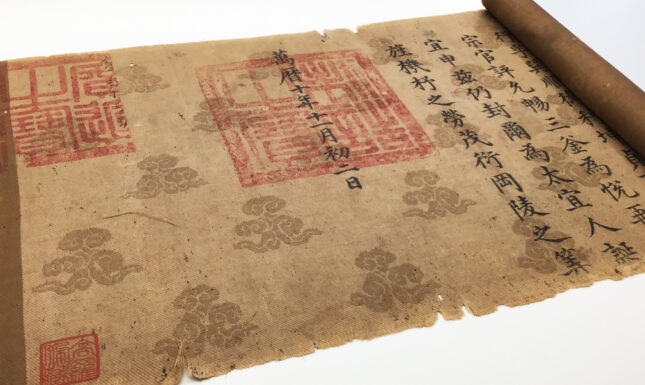

On the scroll (154 x 29 cm) there are some fold-lines and different colourations. The ink is crumbling away and the fold-lines get larger the further one moves away from the original location of the roller. Based on the observation that the characters written farther to the left remain darker than the ones on the other side, we assume that the roller was mounted on the right side. The friction caused by rolling the scroll in and out eroded the characters closest to it.
Ming Dynasty edicts generally consisted of five different sections of almost equal length. According to the edict’s restorers, differences in colouration could be the result of the use of different types of thread, different rinsing methods, or different dyes. On the fabric itself, a cloud-like pattern is visible in the background.
A Bit of Historical Context
Issuing edicts is a political practice with a long tradition in imperial China. This structure was in place as early as the Western Zhou (1045-771 BC) period and continued until the end of the Chinese imperial system in 1911. Throughout the dynasties, Chinese bureaucracies changed and refined aspects like the edict’s length, uses, and ceremonies surrounding its issuance continually. This should come as no surprise because edicts played an integral and multifaceted role in the imperial organization.
While we often use the umbrella term ‘edict’, one study identifies 175 unique historical Chinese terms for these top-down pronouncements of the emperor. One specific category of edict, the 誥命 (gaoming), was aimed at rewarding or punishing high-ranking officials. With these edicts, officials were bestowed (or stripped from) titles, favours, or honours. Receiving such favours from the emperor could mean a great deal to officials and their families as it not only enhanced their social standing but also could include a hereditary salary and rank. The edict, when received by the favoured official, would subsequently be treasured by their family for generations. Only in certain cases like theft could the edict be re-issued. For rulers, the issuing of edicts was a useful tool as well. By rewarding powerful factions or individuals, for example, rulers were able to create loyal allies, further reinforcing their legitimacy and standing.
Not only an official could receive honours; their ancestors, descendants, and wives could also be favoured. The Ming Dynasty edict recently acquired by the Asian Library falls in this category.
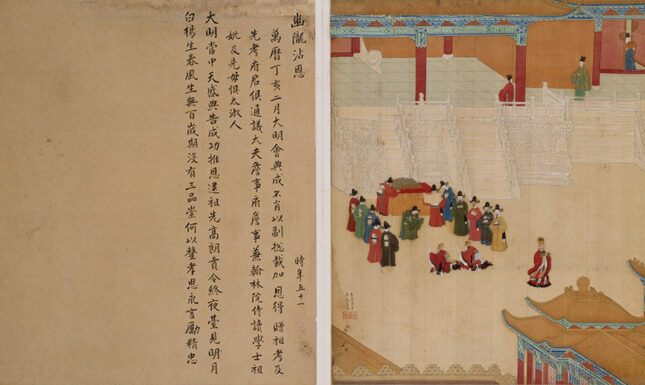

This edict honours the parents of Zhao Fan (趙範, 1543 – 1617). His father and two mothers share in the achievements of their son, as the enablers of their son’s success. The edict, as translated below by Jelle Kuiper, explicitly states: “Whenever an official ascends to court by accumulating learning, his achievement always originates from his father!”
His mothers are also credited, albeit in a slightly different manner, namely as having married well and as having assisted their husband in creating the atmosphere in which their son could rise to the top rank in the civil service examinations, that of jinshi (進士). Their virtues are lauded as being humble, submissive, and of ‘chaste womanhood’. This rhetoric is representative of its age, echoing the cult of female chastity. This trend arose in sixteenth-century century China as women were expected to remain more and more ‘pure’, by remaining chaste after their husband passed away, or even by committing suicide after being sexually assaulted. Stories like these were widely reported in local gazetteers and the women in question could receive rewards from the state, the so-called jingbiao (旌表). These rewards were not solely honorary but included a monetary gift and the privilege of being exempted from corvée duty. An increasing fixation on these awards reinforced the trend.
Reading the Edict
Zhao Fan was born in Zhangpu (漳浦), Fujian Province (blue circle on the map). He received the jinshi degree in 1571, the highest degree in the imperial examination system. His father Zhao Shukuan (趙叔寬 1505-1574) had two wives, and thus he had two mothers. From this edict, we can infer that Zhao Fan’s biological mother was the second wife. She was married to his father after his first wife had died. In 1574 his father died. After three years of filial mourning (丁憂 dingyou), Zhao Fan was appointed subprefectural magistrate of Cizhou (磁州) in 1577.
Zhao Fan received edicts twice. In the first edict, his late father was conferred the title of subprefectural magistrate of Cizhou, and his biological mother the title of “Great Lady of Suitability” (太宜人 taiyiren).
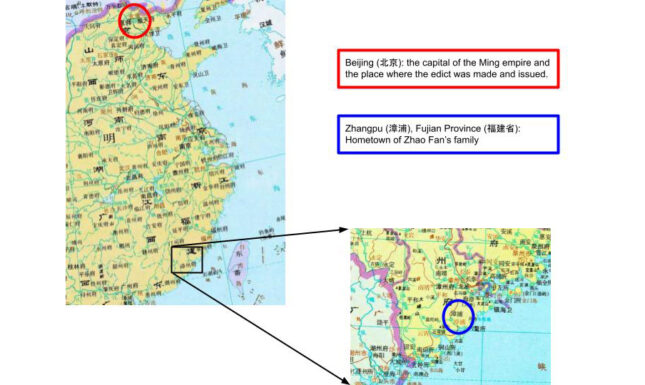

Then, in 1582, Zhao Fan was promoted to ‘Vice Director of the Shaanxi Bureau in the Ministry of Revenue’. This was the year in which he received the second edict, which our library has acquired. The edict was issued in the imperial capital of Beijing (北京 - red circle on the map). Following the same regulations applied to the former promotion in 1577, his father was bestowed the new title. Similarly, his biological mother received the title ‘Great Lady of Suitability’ for the second time, and his “late mother” (his father’s first wife, deceased), who died before 1577, received the title ‘Lady of Suitability’ (宜人 yiren).
In contrast to the biological mother, Zhao Fan’s “late mother” did not receive a title in the first edict. Probably his official rank was not yet high enough to grant her a title as well. Furthermore, the “late mother” only received the title ‘Lady of Suitability’ in the second edict, whereas the biological mother received the title ‘Great Lady of Suitability’ again. We can find a possible explanation for the difference in the Dynastic History of the Ming Dynasty (Zhang Tingyu 張廷玉, comp., Ming shi 明史). A mother of a fifth-rank official was usually granted the title ‘Great Lady of Suitability’ when the father had died and the mother was still alive. This was the case during Zhao Fan’s first promotion when the biological mother received this title. Then, at his second promotion, his biological mother retained the title she had received during the first promotion, but the “late mother”, because she and the father had died, only received the title ‘Lady of Suitability’.
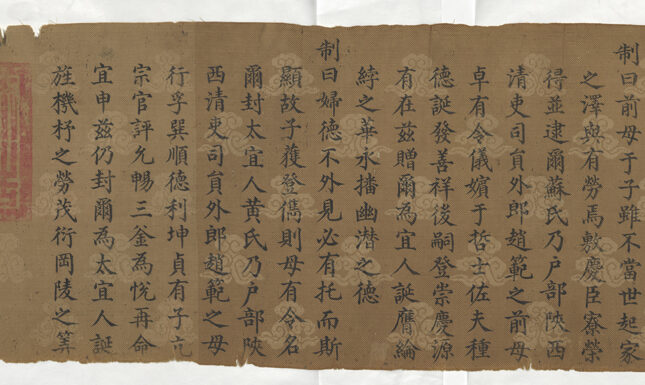

This post is the successful conclusion of a three-month internship for three BA3 and MA Chinese Studies students at Leiden University: Iks van Eijndhoven (historical context), Mauk Evertse (physical description and provenance of the document) and Jelle Kuiper (description of the content and translation). They were assisted in their work by Marc Gilbert, dr. Lin Fan, Liu Jialong, and Professor Hilde De Weerdt.


